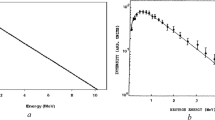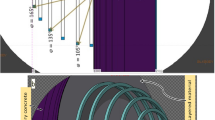Abstract
The literature contains both endorsements of, and advice against, the use of protective apparel in nuclear medicine procedures. The main issues usually centre around: Whether the shielding which can be provided by a protective garment light enough to wear (0 to 0.6 mm lead equivalent at the gamma energies commonly encountered in nuclear medicine) is enough to warrant its use; and (more recently); Whether the dose enhancement behind the protective garment from electron scatter in lead is sufficient to be of concern. In this work, the Monte Carlo code EGSnrc was used to investigate the effectiveness of lead of thicknesses of 0 to 0.6 mm, in shielding staff from photons of energies of 140 and 511 keV. Furthermore, dose escalation behind the lead was investigated. Reasonable dose reductions are obtained at 140 keV with protective garments of 0.5 mm lead equivalence. This perhaps warrants their use, in certain circumstances. At 511 keV, the reduction in dose is less than 10%, and their use is probably not justified (given the weight that has to be carried) from an ALARA point of view. It should be noted here that protective garments designed for X-ray shielding will generally not have the same lead equivalence at the gamma energies used in nuclear medicine. It should also be noted that protective garments which do not contain lead do not always attenuate as much as their stated lead equivalence claims. Dose escalation does occur, but the depth of penetration of the scattered electrons beyond the exit side of the lead shielding is such that it is highly unlikely that a significant dose would be delivered to viable tissue in wearers of protective garments.
Similar content being viewed by others
References
Webb, S., The physics of medical imaging. 1st ed.: IOP Publishing, 1988.
Warren-Forward, H., et al.,A comparison of dose savings of lead and lightweight aprons for shielding of 99m-Technetium. Radia. Prot. Dosim., 2007.
Finnerty, M. and Brennan, P.C.,Protective aprons in imaging departments: manufacturer stated lead equivalence require validation. Eur. Radiol., 2005. 15(7): p. 2005.
Radiation Safety, F.M.C.,Radiation Safety Training and Reference Manual, Radionuclide data sheets for some commonly used radionuclides. 2nd ed. 2003.
Johns, H. and Cunningham, J.,The physics of radiology. 4th ed. Thomas, 1983.
Sorenson, J. and Phelps, M.,Physics in Nuclear Medicine. 2nd ed.: Grune and Stratton, 1987.
Hamilton, D.,Diagnostic Nuclear Medicine: A Physics Perspective. Springer Verlag, 2004
Twaite, K., Borham, P. and Southeel, A.,The use of lightweight aprons to significantly reduce radiation exposure in nuclear medicine. in36th Annual scientific meeting of the Australian and New Zealand Society of Nuclear Medicine. 2007.
ARPANSA,National Conference on Radiation Protection in Medicine, Public Comment Draft. 2007.
Pelz, D.,Low Back Pain, Lead Aprons, and the Angiographer. American Journal of Neuroradiology, 21: p. 1364, 1999.
Kicken, P. and Bos, A.,Effectiveness of Lead Aprons in Vascular Radiology: Results of Clinical Measurements. Radiology, 197(2): p. 473–478, 1995.
Muir, S., McLeod, R. and Dove, R.,Light-weight aprons: light on weight. protection or labelling accuracy? Australas. Phys. and Eng. Sci. in Med., 28(2): p. 128–130, 2005.
Regulla, D., Hieber, D. B. and Seidenbusch, M.,Physical and biological interface dose effects in tissue due to X-ray-induced release of secondary radiation from metallic gold surfaces. Radiation Research, 150(1): p. 92–100, 1998.
Cheung, J. and Tang, F.,The calculation of dose enhancement close to platinum implants for skull radiography. Health Physics, 93(4): p. 267–292, 2007.
Groth, M.,Empirical dose rate and attenuation data for radionuclides in nuclear medicine. Australas. Phys. and Eng. Sci. in Medicine, 19(3), 1996.
Wikipedia,http://en.wikipedia.org/wiki/Technetium-99m.
Steyn, P. and Uhrig, J.,The role of protective lead clothing in reducing radiation exposure rates to personnel during equine bone scintigraphy. Veterinary Radiology and Ultrasound, 46(6): p. 529–532, 2005.
Bushberg, J.T.,The essential physics of medical imaging. 2nd ed. Lindcott, William and Wilkins, 2002.
Roberts, F., et al.,Radiation Dose to PET Technologists and Strategies to Lower Occupational Exposure. J. Nucl. Med. Technol., 33: p. 44–47, 2005.
Walters, B., Kawrakow, I. and Rogers, D. W. O,DOSXYZnrc Users Manual. Ionizing Standards National Research Council of Canada, 2006.
Kawrakow, I.,The EGSnrc code system: Monte Carlo Simulation of Electron and Photon Transport. Ionizing Radiation Standards, National Research Council of Canada, 2006.
Kawrakow, I. and Walters, B.R.B.,Efficient beam dose calculations using DOSXYZnrc and BEAMnrc. Med. Phys., 33(8): p. 3046–3056, 2006.
ICRU,International Commission on Radiation Units and Measurements: Report no. 56: Dosimetry of External Beta Rays for Radiation Protection, 1997.
http://en.wikipedia.org/wiki/Cotton.
Author information
Authors and Affiliations
Corresponding author
Rights and permissions
About this article
Cite this article
Fog, L.S., Collins, P. Monte Carlo simulation of the dose to nuclear medicine staff wearing protective garments. Australas. Phys. Eng. Sci. Med. 31, 307–316 (2008). https://doi.org/10.1007/BF03178600
Received:
Accepted:
Issue Date:
DOI: https://doi.org/10.1007/BF03178600




